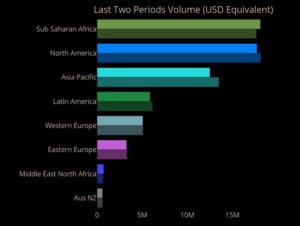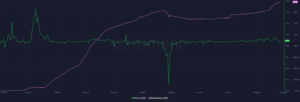Energy and utility (E&U) companies are no strangers to emergencies. As part of the critical infrastructure that makes up our lives, E&U companies are prepared for and respond to numerous disasters. But even the most robust business resiliency plans were thrown by a pandemic with no event horizon in place. And in a post-COVID world, a shifting — or nonexistent “normal” may exert unique pressures on E&U operations.

Terry Saunders, IBM Worldwide Utilities Industry Leader
We recently sat down with Terry Saunders, Worldwide Utilities Industry Leader for IBM Cloud and Cognitive Software. An expert in the energy and utility space and with 20+ years experience with IBM Maximo, Terry talked about what happens when you combine a pandemic with changing views about sustainability and a coming global energy transition. As Terry described it, this is driving structural shifts in the industry, and challenging leaders to adopt new strategic and operational imperatives.
Below is part one of a two-part series with our questions and his answers.
Q: Your customers have had a challenging year. How have they handled this … what were the impacts?
In the beginning of the pandemic, I don’t think people really understood what an essential worker was — that it extended beyond police, fire, and EMTs to grocery store workers and pharmacy employees. Then, when we all started to think about it, we realized electric, gas, and water employees are very essential. We all need drinking water, lights that turn on, and to not freeze to death.

Regardless of the weather or a pandemic, E&U companies have to provide dependable power.
These folks couldn’t stop working, yet they had to change the way they work. There’s all kinds of supporting people in addition to the field folks. The support staff were used to working in offices and they were not prepared for working from home. Many may not have had a laptop or adequate internet service. So, all this had to be tested and tried. They also might not have had an adequate working environment at home. So, there was that shift.
Protecting the people who keep the lights on
Then there was the shift of people working in the field. Suddenly, they were faced with needing PPE. Did they have it? Some, but not enough. Where a utility crew in a bucket truck used to show up in one vehicle, now they had to show up in separate vehicles to remain socially distanced. So, the companies reoriented the way they planned and scheduled work. They had to make decisions on what work was considered critical. Many utility crews were sequestered and couldn’t go home. The utility companies brought in RVs and trailers, set up cafeterias and sleeping accommodations at service centers and the plants. Employees couldn’t risk leaving a major power plant, go home and possibly get exposed to COVID, then be unable to return to work. Some people didn’t return home to their families for 60 or 90 days to make sure the rest of us had utilities.

When everyone suddenly went home, E&U employees were the essential workers responsible for keeping the power on.
All that translated into not only to workplace disruption, but to additional costs — right at a time when the utilities had less money coming in. Customers were often unable to pay their bills because of job loss or uncertainty about their own future. So people stopped paying utility bills and the utilities could not legally collect. In addition, companies shifted from offices to homes, so that caused changes in how utilities were distributed. It also meant higher residential utility bills and yet the companies were getting less money coming in.
Q: What technology have they used to overcome these challenges?
The positive that has come out of this is that utility companies have realized the true nature of resiliency which, for them, means access and understanding of the status of utility networks, of employees, of equipment — and to be able to do it from anywhere, anytime, and any place. That’s caused a new understanding of efficiency in the ways of work.
Because of this, we are seeing a change to cloud adoption and cloud services. So, even though some utilities had resisted cloud adoption, they began to view the cloud with a new perspective. They began to turn to IBM and other cloud and remote technology providers to deliver more resilience for their operations. These companies are looking at pushing out legacy applications and moving to a more modern infrastructure that takes less bandwidth and can be operated from anywhere. The experience of the global pandemic exposed the weaknesses of legacy systems and network architectures. A renewed sense of urgency and appreciation of business benefits have emerged for adoption of cloud and cognitive solutions.
Q: What is next for energy and utility from a technology or business perspective?
Utilities have started to see the benefits to working remotely. They saved 20% to 30% in costs just by not having people travel to meetings. Suddenly, they accepted that you could work virtually and, when we come out of this, I think we’ll all ask, who really needs to travel for a meeting, and you’ll gain even more cost efficiencies. Many of us will engage a hybrid model in the new normal and plan and schedule differently continuing to engage virtually as a new option.
During the shutdown, I was working with a European utility and I brought in IBM experts and business partners from Switzerland, Germany, Slovenia, Ireland, Brazil and the United States. I could bring in the best people in the world. Pre-pandemic, I would have never been able to get the funding to fly in all these people. As I was presenting, the remote team was monitoring the chat and the client was getting answers in real-time — without disturbing the flow of the presentation.
Conferences will be challenged and there will be fewer of them with fewer attendees. The Maximo Utilities Working Group (www.muwg.org) conference was virtual in 2020 and 2021. Nevertheless, we had 761 people registered and 10 countries represented. We’ve never had that many people or countries represented at the conference. We’ll have our next event in person this fall, hosted by the Southern companies in Birmingham, Alabama. We expect we will have less than the 500+ people who use to attend in-person conferences, so we plan to adapt and adjust in the new normal for the best benefit of our 200-plus member utilities.
Resources for energy and utility organizations
Source: https://www.ibm.com/blogs/internet-of-things/energy-and-utility-with-terry-saunders-part-1/
- 2020
- 2021
- access
- Additional
- Adoption
- Alabama
- All
- applications
- BEST
- Bills
- Birmingham
- Brazil
- business
- Business Benefits
- caused
- change
- Cloud
- cloud adoption
- cloud services
- cognitive
- coming
- Companies
- Conference
- conferences
- Conversation
- Costs
- countries
- Covid
- Critical Infrastructure
- Customers
- DID
- disasters
- Disruption
- driving
- efficiency
- Electric
- electricity
- employees
- energy
- Environment
- equipment
- European
- Event
- experts
- families
- Fire
- flow
- Freeze
- funding
- future
- GAS
- Germany
- Global
- global pandemic
- grocery
- Group
- Home
- How
- HTTPS
- Hybrid
- IBM
- IBM Cloud
- industry
- industry Leader
- Infrastructure
- Internet
- ireland
- IT
- Job
- keeping
- laptop
- Line
- major
- meetings
- money
- monitoring
- network
- networks
- Operations
- Option
- Other
- pandemic
- Pay
- People
- perspective
- pharmacy
- plants
- Police
- power
- PPE
- real-time
- REST
- Risk
- sense
- Sense of Urgency
- Series
- Services
- set
- shift
- shutdown
- Slovenia
- So
- Software
- Solutions
- Southern
- Space
- started
- States
- Status
- store
- Strategic
- support
- Sustainability
- switzerland
- Systems
- Technology
- time
- travel
- truck
- United
- United States
- us
- utilities
- utility
- vehicle
- Vehicles
- Virtual
- Water
- What is
- WHO
- Work
- workers
- working from home
- Workplace
- world
- worldwide
- year
- years





